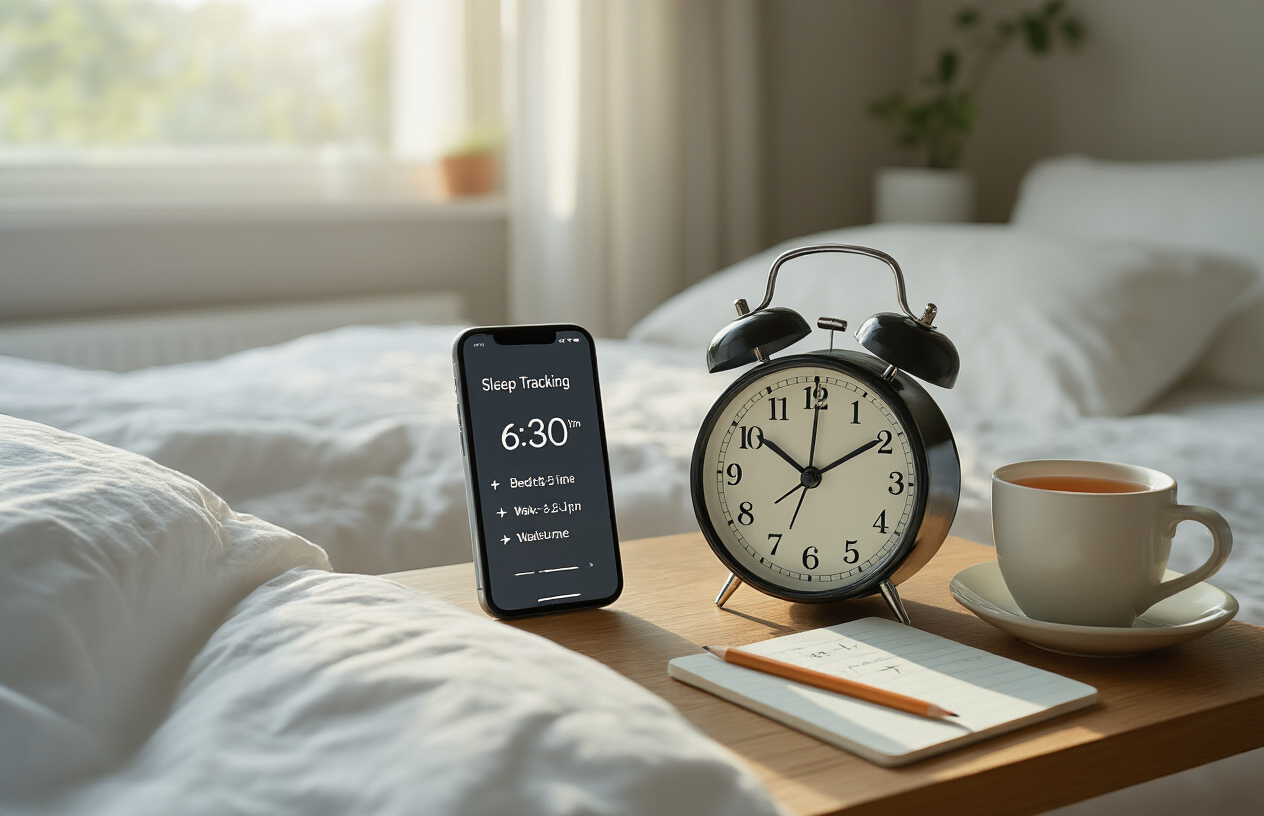Getting enough quality sleep can transform your energy levels, mood, and overall health, but finding your perfect bedtime isn’t just about counting backwards eight hours from when you wake up. This guide is for anyone who struggles with falling asleep, waking up groggy, or feeling tired throughout the day despite spending plenty of time in bed.
Your ideal bedtime depends on your unique sleep cycles, personal sleep needs, and daily schedule. We’ll walk you through how to understand your natural sleep rhythms and determine exactly how much sleep your body actually needs. You’ll also learn a simple method to work backwards from your wake-up time and discover practical ways to create the perfect sleep environment that supports your new schedule.
Understand Your Sleep Cycles and Natural Rhythms

Master the 90-minute sleep cycle pattern
Your brain moves through distinct stages of sleep in predictable 90-minute cycles throughout the night. Each cycle includes light sleep, deep sleep, and REM (Rapid Eye Movement) sleep. Understanding this pattern is your secret weapon for waking up refreshed instead of groggy.
During the first half of each cycle, you experience light sleep where your body temperature drops and heart rate slows. The middle portion brings deep sleep – this is when your body repairs tissues, consolidates memories, and releases growth hormones. The final stage delivers REM sleep, where vivid dreams occur and your brain processes emotions and information.
Waking up mid-cycle, especially during deep sleep, leaves you feeling disoriented and tired regardless of how many hours you slept. This explains why sometimes you feel more rested after six hours than after eight hours of sleep.
Plan your bedtime to complete full 90-minute cycles before your alarm goes off. If you need to wake up at 7 AM, count backwards in 90-minute increments: 5:30 AM, 4:00 AM, 2:30 AM, 1:00 AM, 11:30 PM, or 10:00 PM. Choose the bedtime that allows for 5-6 complete cycles while fitting your schedule.
Identify your chronotype for optimal timing
Your chronotype determines whether you’re naturally wired as an early bird, night owl, or somewhere in between. This genetic programming affects when your body produces melatonin, when your core temperature peaks, and when you feel most alert.
Morning types (larks) feel energized early in the day and naturally wind down by evening. Their melatonin production starts around 9 PM, making them ready for sleep by 10-11 PM. They typically perform best on cognitive tasks between 8 AM and noon.
Evening types (owls) hit their stride later in the day and struggle with early morning commitments. Their melatonin doesn’t kick in until after 11 PM, pushing their ideal bedtime to midnight or later. They often feel most creative and productive in the late afternoon and evening hours.
Intermediate types fall between these extremes, adapting more easily to varying schedules while maintaining moderate flexibility in their sleep-wake timing.
To identify your chronotype, pay attention to your natural energy patterns during weekends or vacations when external schedules don’t force specific wake times. Notice when you feel most alert, when you naturally get hungry, and when sleepiness hits without caffeine or artificial lighting interfering.
Calculate total sleep cycles needed for peak performance
Most adults need 5-6 complete sleep cycles per night, translating to 7.5-9 hours of total sleep time. However, your personal requirements depend on factors like age, activity level, stress, and overall health.
Age plays a significant role in cycle requirements:
- Young adults (18-25): Often need 6 full cycles (9 hours)
- Adults (26-64): Typically require 5-6 cycles (7.5-9 hours)
- Older adults (65+): May function well on 5 cycles (7.5 hours)
Athletes and people under high stress usually need additional recovery time, pushing them toward 6 cycles nightly. During illness or intense training periods, some people benefit from 7 cycles (10.5 hours).
Start by tracking your natural sleep patterns for one week. Note how many cycles you complete on nights when you feel most rested the following day. This becomes your baseline requirement.
Quality matters as much as quantity. Five complete, uninterrupted cycles often provide better restoration than seven fragmented ones. Focus on creating conditions that allow you to move smoothly through each sleep stage without frequent awakenings that reset your cycle progress.
Determine Your Personal Sleep Requirements

Assess Your Age-Based Sleep Duration Needs
Sleep requirements change dramatically throughout your life, and understanding where you fall on this spectrum is the foundation of calculating your perfect bedtime. Newborns sleep up to 17 hours daily, while adults typically need between 7-9 hours. But here’s where it gets interesting – these aren’t just arbitrary numbers.
Your brain and body undergo different processes at various life stages. Teenagers actually need more sleep than adults (8-10 hours) because their brains are still developing and their circadian rhythms naturally shift later. Adults in their 20s through 60s generally thrive on 7-9 hours, while those over 65 often find 7-8 hours sufficient as sleep becomes lighter and more fragmented.
| Age Group | Recommended Sleep Duration |
|---|---|
| 18-25 years | 7-9 hours |
| 26-64 years | 7-9 hours |
| 65+ years | 7-8 hours |
Don’t treat these as rigid rules. Some people are natural short sleepers who feel fantastic on 6 hours, while others need a solid 9-10 hours to function optimally. Your genetics play a significant role here – if your parents were early risers who needed minimal sleep, you might share those traits.
Factor in Your Lifestyle and Activity Level
Your daily activities directly impact how much sleep your body demands for proper recovery. Athletes and people with physically demanding jobs need more sleep than desk workers because muscle repair and growth hormone release happen primarily during deep sleep stages.
Mental stress also increases sleep requirements. If you’re going through a challenging period at work, studying for exams, or dealing with personal stress, your brain needs extra time to process information and consolidate memories. High-stress periods often require an additional 30-60 minutes of sleep.
Consider these lifestyle factors that increase sleep needs:
- Intense physical exercise or manual labor
- High-stress work environments
- Irregular schedules or shift work
- Frequent travel across time zones
- Chronic illness or recovery from illness
- Pregnancy or breastfeeding
Account for Individual Sleep Debt and Recovery Time
Sleep debt accumulates when you consistently get less sleep than your body needs. Unlike financial debt, you can’t simply “pay it back” with one long sleep session. Recovery requires consistent, adequate sleep over several nights or even weeks.
If you’ve been running on 5-6 hours nightly for months, jumping straight to your ideal bedtime might leave you feeling groggy initially. Your body needs time to adjust and clear the backlog of cellular repair work that’s been piling up. Start by adding 15-30 minutes to your current sleep duration each week until you reach your target.
Signs you’re carrying sleep debt include:
- Falling asleep within minutes of hitting the pillow
- Needing caffeine to function in the morning
- Feeling tired despite getting “enough” sleep
- Catching every cold that goes around
- Difficulty concentrating or making decisions
Recognize Quality Versus Quantity Indicators
Eight hours in bed doesn’t guarantee eight hours of quality sleep. Sleep efficiency – the percentage of time you’re actually asleep while in bed – matters more than total time spent lying down. Healthy adults typically achieve 85-90% sleep efficiency.
Pay attention to how you feel upon waking rather than obsessing over total hours. Quality sleep leaves you feeling refreshed and alert within 15-30 minutes of waking. If you need multiple alarms or feel foggy for hours after getting up, you might need to adjust your sleep timing or address sleep quality issues.
Quality indicators include:
- Waking up naturally before your alarm
- Feeling refreshed within 30 minutes of waking
- Maintaining steady energy throughout the day
- Falling asleep within 15-20 minutes of lying down
- Minimal nighttime awakenings
Track both your sleep duration and morning energy levels for at least two weeks to identify patterns. Your perfect bedtime isn’t just about hitting a number – it’s about finding the sweet spot where duration meets quality for your unique situation.
Work Backwards from Your Wake-Up Time

Set your non-negotiable morning alarm
Your wake-up time serves as the cornerstone for calculating your perfect bedtime. Start by identifying when you absolutely must be awake and alert. This isn’t about when you’d like to wake up on weekends, but rather the earliest time you need to function at full capacity during your busiest days.
Consider your morning routine requirements: Do you need 30 minutes to shower and get dressed, or do you prefer a leisurely hour with coffee and breakfast? Factor in commute time, morning workouts, or family responsibilities. Your alarm should ring early enough to handle these activities without rushing.
Write down your target wake-up time and commit to it for at least two weeks. Consistency matters more than perfection when establishing your sleep schedule. Even if you’re naturally a night owl, maintaining the same wake-up time seven days a week helps regulate your circadian rhythm.
Count backwards in 90-minute intervals
Sleep cycles last approximately 90 minutes, moving through light sleep, deep sleep, and REM stages. Waking up at the end of a complete cycle leaves you feeling refreshed rather than groggy. This biological rhythm makes 90-minute intervals your best friend when calculating bedtime.
From your wake-up time, count backwards in these increments:
- 7.5 hours (5 cycles): Minimum for most adults
- 9 hours (6 cycles): Sweet spot for many people
- 10.5 hours (7 cycles): Ideal for heavy sleepers or during recovery
For example, if you wake at 6:00 AM:
- 10:30 PM (7.5 hours)
- 9:00 PM (9 hours)
- 7:30 PM (10.5 hours)
Your personal sleep requirement determines which option works best. Start with the middle option and adjust based on how you feel after a week of consistent timing.
Add buffer time for falling asleep
Most people don’t fall asleep the moment their head hits the pillow. Account for this transition period by adding 15-30 minutes to your calculated bedtime. If you typically take longer to drift off, especially during stressful periods, allow extra buffer time.
Your buffer time should reflect realistic expectations, not wishful thinking. Track how long you actually spend lying awake over several nights to establish your personal average. Some people fall asleep within five minutes, while others need 45 minutes to wind down mentally.
Add this buffer to your 90-minute calculation. If your optimal sleep time is 10:30 PM and you need 20 minutes to fall asleep, plan to be in bed by 10:10 PM. This approach prevents the anxiety that comes from lying awake watching the clock tick past your intended sleep time.
Create Your Optimal Sleep Environment

Design the perfect bedroom temperature and lighting
Your bedroom temperature plays a huge role in how quickly you fall asleep and how well you stay asleep throughout the night. The sweet spot for most people falls between 65-68°F (18-20°C). When your body temperature naturally drops in the evening, a cooler room helps signal that it’s time to sleep. If your room is too warm, your body has to work harder to cool down, which can keep you tossing and turning.
Lighting is equally critical for quality sleep. Your brain produces melatonin when it gets dark, so you want to minimize all light sources at least an hour before bedtime. Install blackout curtains or blinds to block outside light from streetlamps or early morning sun. Cover any LED lights on electronics with tape, and consider using an eye mask if complete darkness isn’t possible.
Red-tinted light bulbs or warm-colored smart bulbs can help during your evening routine since they don’t suppress melatonin production like blue and white light do. A small salt lamp provides just enough warm glow for navigating your room without disrupting your sleep hormones.
Eliminate sleep-disrupting technology and distractions
Electronics are sleep’s biggest enemy, yet most of us keep phones, tablets, and TVs right in our bedrooms. The blue light from screens tricks your brain into thinking it’s still daytime, suppressing melatonin for hours after you’ve put the device down.
Create a charging station outside your bedroom for all devices, or at minimum, keep them across the room rather than on your nightstand. If you absolutely must keep your phone nearby for emergencies, put it in airplane mode and face it down. Replace your phone’s alarm with a traditional alarm clock to remove the temptation to check messages.
Remove or relocate these common sleep disruptors:
- TVs and computers
- Gaming systems
- Work materials and laptops
- Bright digital clocks (dim them or turn them away)
- Exercise equipment
- Laundry piles or cluttered surfaces
Your bedroom should feel like a sanctuary, not an extension of your office or entertainment center. Keep only sleep-related items in this space.
Establish calming pre-bedtime rituals
A consistent routine tells your body and mind that sleep time is approaching. Start your wind-down process 30-60 minutes before your target bedtime. This buffer time allows your nervous system to shift from the day’s stress into relaxation mode.
Effective pre-sleep activities include:
- Taking a warm bath or shower (the temperature drop afterward mimics natural sleep signals)
- Reading a physical book or magazine
- Gentle stretching or yoga poses
- Writing in a journal or gratitude list
- Listening to calm music or nature sounds
- Practicing deep breathing exercises
Avoid stimulating activities like intense exercise, work emails, financial planning, or emotionally charged conversations. These activities spike cortisol levels and can keep your mind racing long after you’ve gotten into bed.
Keep your routine simple and enjoyable so you’ll actually stick with it. Even just dimming the lights and spending 10 minutes reading can make a significant difference in how quickly you fall asleep.
Optimize your mattress and pillow setup
Your mattress and pillow setup directly impacts both comfort and spinal alignment. A mattress that’s too soft can cause back pain by not providing adequate support, while one that’s too firm might create pressure points that wake you up throughout the night.
Most mattresses need replacement every 7-10 years, but pay attention to these signs that yours might be affecting your sleep:
- Waking up with aches and pains
- Sleeping better in hotels or guest beds
- Visible sagging or worn spots
- Feeling springs or lumps
Your pillow should keep your neck and spine in neutral alignment. Side sleepers typically need thicker, firmer pillows, while back sleepers do better with medium support. Stomach sleepers should use thin pillows or none at all to avoid neck strain.
Consider these additional comfort factors:
| Factor | Recommendation |
|---|---|
| Sheets | Breathable materials like cotton or bamboo |
| Room humidity | 30-50% for optimal comfort |
| Noise control | White noise machine or earplugs if needed |
| Air quality | Good ventilation, air purifier if necessary |
Replace pillows every 1-2 years, as they lose support and accumulate allergens over time. Your sleep setup is an investment in your health and daily performance, so don’t compromise on quality where you spend a third of your life.
Fine-Tune Your Bedtime Through Testing and Tracking

Track Your Energy Levels and Mood Patterns
Start keeping a simple daily log of how you feel at different times throughout the day. Rate your energy on a scale of 1-10 when you wake up, mid-morning, afternoon, and evening. Notice patterns – do you consistently crash at 3 PM? Feel most alert at 10 AM? These patterns reveal crucial information about your natural circadian rhythm and whether your current bedtime supports optimal daytime functioning.
Pay attention to your mood alongside energy levels. Irritability, difficulty concentrating, or feeling emotionally flat often signal insufficient or poorly-timed sleep. Create a basic tracking system using your phone’s notes app or a simple notebook. After two weeks, you’ll spot clear trends that guide your bedtime adjustments.
Adjust Bedtime Incrementally for Best Results
Making dramatic bedtime changes rarely sticks. Instead, shift your bedtime by just 15-30 minutes earlier or later every few days. This gradual approach allows your body clock to adapt naturally without resistance. If you’re currently going to bed at midnight but want to sleep by 10:30 PM, take two weeks to make this transition.
Start with the easiest change first. If you need to go to bed earlier, begin dimming lights and avoiding screens 30 minutes before your target bedtime. Your body will start producing melatonin earlier, naturally making you feel sleepy at the right time. Patience pays off – rushing the process often leads to lying awake frustrated or reverting to old habits.
Monitor Sleep Quality Using Simple Indicators
Quality matters more than quantity when evaluating your bedtime success. Track these key indicators without expensive gadgets:
- Morning alertness: Do you wake up naturally or need multiple alarms?
- Daytime focus: Can you concentrate on tasks without excessive caffeine?
- Physical recovery: Do muscles feel rested and joints move easily?
- Emotional stability: Are you patient and optimistic throughout the day?
Keep notes about factors that improve or worsen these indicators. Maybe you sleep deeper when you avoid late dinners, or feel more refreshed when your room temperature is cooler. Small environmental changes often produce significant improvements in sleep quality.
Make Seasonal and Lifestyle Adjustments
Your perfect bedtime isn’t static – it shifts with seasons, work schedules, and life changes. During shorter winter days, you might naturally want to sleep earlier and longer. Summer’s extended daylight could push your optimal bedtime later. Listen to these seasonal cues rather than fighting them.
Life transitions require bedtime recalibration. New job stress, exercise routine changes, or relationship shifts all affect sleep needs. Pregnant women, shift workers, and people dealing with health issues need to adjust their approach entirely. Flexibility prevents frustration and keeps your sleep schedule realistic and sustainable.
Review and adjust your bedtime every few months, especially when daylight saving time changes or your daily routine shifts significantly.

Finding your perfect bedtime isn’t about following generic advice or forcing yourself into someone else’s sleep schedule. It’s about understanding how your body naturally works, figuring out exactly how much sleep you need, and then working backwards from when you need to wake up. Once you’ve nailed down the timing, creating the right environment and tracking what actually works for you makes all the difference.
Start tonight by paying attention to your natural energy patterns and sleep cycles. Calculate your ideal bedtime based on your wake-up time and personal sleep needs, then commit to testing it for at least a week. Your body will thank you with better energy, sharper focus, and improved overall health. The perfect bedtime is out there waiting for you – you just need to do the math and give your body time to adjust.














